- Quick Read
- Deep Read ( 7 Min. )
In Today’s Issue
- Afghan journalists’ battle: To keep free expression alive
- Why Canadian elections aren’t following the polarized US example
- Russians vote Sunday. Why don’t dirty tricks dissuade the opposition?
- Pandemic took bite out of US economy. Yet millions escaped poverty.
- Is ‘Persuasion’ the Jane Austen story we all need right now?
Monitor Daily Podcast
- Follow us:
- Apple Podcasts
- Spotify
- RSS Feed
- Download
TODAY’S INTRO
The resilience of one Gold Star mom
Susan Coti has long been an educator. On Sept. 11, 2001, she was my daughter’s fourth-grade teacher at John Eaton Elementary School in Washington, D.C. Today, she helps run a nonprofit for Burmese teachers of English in Myanmar.
The pandemic halted in-person training, and then the military coup in February suspended the program altogether. This past week, Gift of Education started a new program teaching children who are unable to attend government schools. And students are eager: Two walk 35 minutes each way from a teak logging camp in the mountains to a village with internet access.
Ms. Coti’s professional evolution didn’t happen in a vacuum. In 2012, her Marine son, Niall Coti-Sears, was killed by an IED in Afghanistan. Ever since, this Gold Star mom has devoted herself to honoring the life of her only child in ways he would find meaningful.
Niall was a musician interested in Buddhism, and Ms. Coti channeled her energy toward funding an instrumental program at a music school in Yangon, Myanmar. Then she pivoted toward the training of English teachers, and joined forces with Sunda Khin, founder of Gift of Education.
“We believe it will elevate the economic and social growth of Myanmar,” Ms. Coti says. “Everybody wants to learn English.”
And how has she processed the U.S. pullout from Afghanistan?
“Even though the Taliban have taken over again (inevitable), I am glad we are out of there,” she writes in an email. “Niall felt he was doing something good there, and that means a lot to me. I won’t go down the ‘died for nothing’ road.”
“I just have to do something to keep moving forward and remembering Niall in a positive way,” she says. “It nourishes me and hopefully the world.”
Share this article
Link copied.

Help fund Monitor journalism for $11/ month
Already a subscriber? Login

Monitor journalism changes lives because we open that too-small box that most people think they live in. We believe news can and should expand a sense of identity and possibility beyond narrow conventional expectations.
Our work isn't possible without your support.
Afghan journalists’ battle: To keep free expression alive
How well, and how long, the Taliban will tolerate independent journalism will be telling. Many Afghan reporters fled amid threats, but others stayed, boldly continuing to do their jobs.
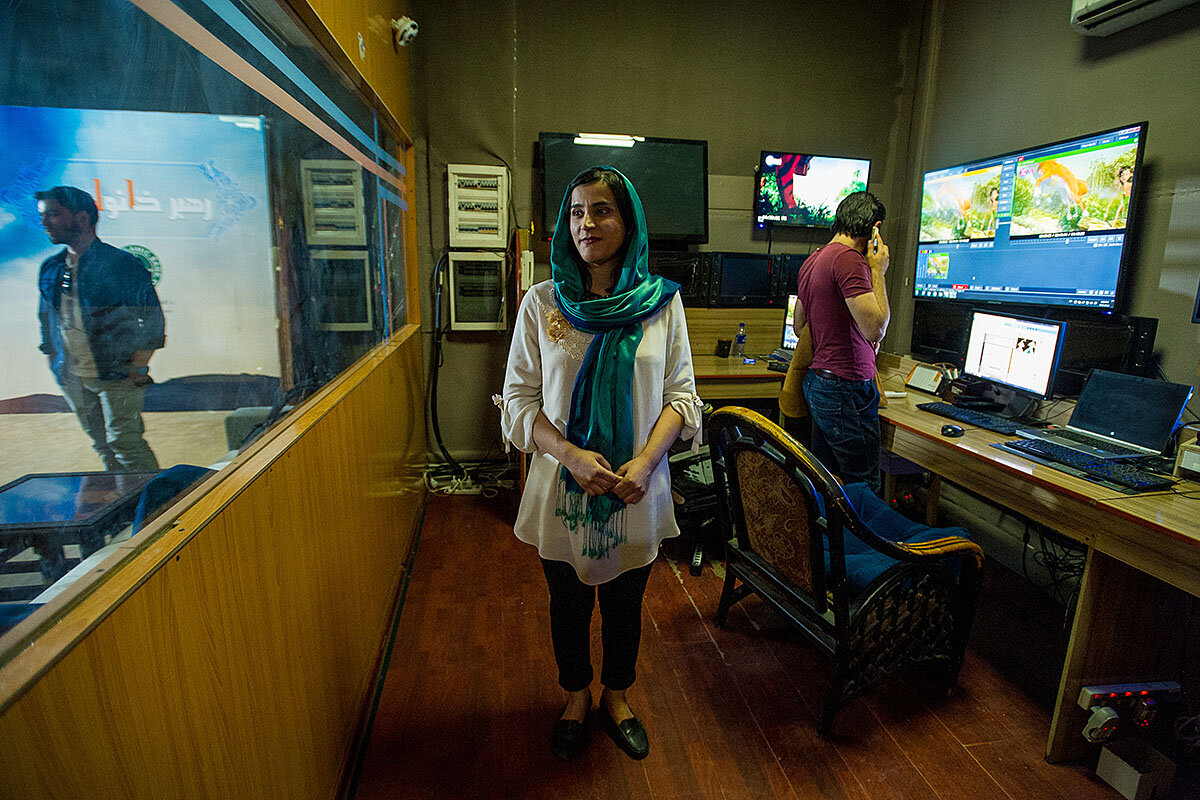
Over 20 years of an American and Western presence that enabled a vibrant media landscape in Afghanistan, the Taliban and other Islamists often targeted journalists in suicide attacks and bombings. Yet today the Taliban have officially declared the media “free and independent” to work, unlike when they last ruled Afghanistan from 1996 to 2001.
Still, Afghan journalists are reeling from beatings, detentions, and ever-tighter Taliban restrictions on what can be reported that raise questions about the future of free expression in Afghanistan.
“Anyone who says we are not doing our job is obviously not watching our TV stations and programs,” says Saad Mohseni, head of the Moby media group, which includes the 24-hour Tolo News channel. “But for how long? I’m not sure,” says Mr. Mohseni, contacted in London. Tolo News notes that 153 local media organizations have shut down across Afghanistan in the past month.
“I don’t want to get too optimistic, because I know things can change quickly,” Mr. Mohseni says. “And I don’t want to be too pessimistic, because so far [the Taliban] have given us enough freedom for us to be able to continue with our work.
“It’s not even a day-to-day proposition,” he says. “It’s an hour-by-hour proposition.”
Afghan journalists’ battle: To keep free expression alive
The message of the vengeful Taliban fighters was clear when they raided the offices of state-owned Radio Television Afghanistan (RTA) in Logar province, as the region south of Kabul fell to the jihadist juggernaut in mid-August.
An Afghan journalist describes being severely beaten as the Taliban destroyed his computer with an assault rifle, then trashed the television and radio studio.
“Shut up and don’t raise your voice!” a fighter warned the journalist. “If you raise your voice, we will kill you.”
For days afterward, he had nightmares that the Taliban would break into his house and slay him – as they had slaughtered scores of journalists, civil society activists, and officials in a recent assassination campaign.
Instead, the journalist received a call from the Taliban, ordering him to “return to his duty” and broadcast again – but under Taliban direction.
“They need us for some time because there is no technical person in their team,” says the journalist, who asked that his name not be used for his safety. “Maybe they will kill us in the near future.”
The fluctuating circumstances of reporting in Logar are a reflection of the high-stakes uncertainty facing journalists across Afghanistan, as they struggle to navigate what some might call the new “Age of the Taliban.”
Twenty years of the American and Western presence enabled a vibrant and freewheeling media landscape, during which the Taliban and other Islamists often targeted journalists in suicide attacks and bombings.
Yet today the Taliban have officially declared the media “free and independent” to work, unlike when they last ruled Afghanistan from 1996 to 2001. The militants have themselves become adept at using the press and social media as tools to gain diplomatic and military advantage.
Still, Afghan journalists are reeling from beatings, detentions, and uncertainty – even from an exodus of colleagues from the country, as the Taliban impose ever-tighter restrictions on what can be reported – that raise questions about the future of free expression in Afghanistan.
“An hour-by-hour proposition”
“Anyone who says we are not doing our job is obviously not watching our TV stations and programs,” says Saad Mohseni, head of the Moby media group, which includes the country’s largest private broadcaster, Tolo TV, and its sister, 24-hour channel Tolo News. Journalists “are reporting on things. They may do it in a slightly different way.”
“But for how long? I’m not sure,” says Mr. Mohseni, contacted in London. Tolo News notes that 153 local media organizations across nearly two-thirds of Afghanistan’s provinces have shut down in the past month.
“I don’t want to get too optimistic, because I know things can change quickly,” he says. “And I don’t want to be too pessimistic, because so far [the Taliban] have given us enough freedom for us to be able to continue with our work.
“It’s not even a day-to-day proposition,” says Mr. Mohseni. “It’s an hour-by-hour proposition.”

Even with Afghanistan now under Taliban control, Tolo News has reported on allegations of Taliban human rights violations in the Panjshir Valley, as well as on anti-Taliban street protests and the beatings of journalists covering those protests. They include brutalities meted out last week with batons, electric cables, and whips against two staffers of the Etilaat Roz newspaper.
Yet when photographer Nematullah Naqdi asked why he was being beaten, he was told: “You are lucky you weren’t beheaded,” Agence France-Presse (AFP) reported.
Journalists seen as spies and enemies
Journalism has always been a hazardous profession in Afghanistan, with even top local news organizations subjected to abuse and raids by disgruntled officials of previous U.S.-backed governments.
And over the years the Taliban, as well as Islamic State jihadists, added to the pressure – and the toll of scores dead – as they accused the media of spouting pro-Western “propaganda.”
“They see us as enemies,” Etilaat Roz reporter Taqi Daryabi told AFP after his beating.
Indeed, Taliban outlets in the past often criticized journalists as “spies of infidel occupiers.” Tolo TV itself was targeted by the Taliban in 2016, when a suicide bomber struck an employee bus, killing seven. Though the Taliban then called the entertainment channel “the country’s largest network for promoting obscenity, irreligiousness, foreign culture and nudity,” now a Taliban official has appeared on Tolo News, interviewed by a female anchor.
“You know, Afghans will get the news somehow,” says Mr. Mohseni. “And this is what we are telling the Taliban, that freedom of expression is good. ... So there’s this ongoing dialogue that may lead to nothing. But we have to give it a shot.
“This is the party that has God on its side. How willing are they to be challenged?” he says. “What if a particular minister is challenged? That’s when the test will come.”
“You are not allowed”
For some Afghan journalists, the verdict is already in, and it is devastating. Sheba Popalzai, a news reporter for Khurshid TV, a culture and games channel that is now off the air, says she is “at home in despair and hopeless.”
“After 16 years of study and aspirations and four years working in different media, I did not think I would ever face such a bad fate,” Ms. Popalzai says in Kabul.
“The media that broadcast before the Taliban is different from the media broadcasting today,” she says. “Every journalist has to change the way they work in order to protect their life, because they are afraid of being arrested and beaten by the Taliban.
“I dreamed of being a prominent journalist,” says Ms. Popalzai. “But with the arrival of the Taliban, all my hopes were dashed and buried forever.”
Indeed, new restrictions have especially grated on female journalists. Days after Kabul fell, senior Taliban leader Wahidullah Hashemi said women “do not have the right” to be reporters or news anchors, which “is not allowed in our government.”
Proof came that very day, when Shabnam Dawran, a widely recognized anchor for RTA, was turned away from work by the Taliban because she was female, despite her staff press card.
“They told me that the regime has changed. ‘You are not allowed, go home,’” she said in a tweeted video.
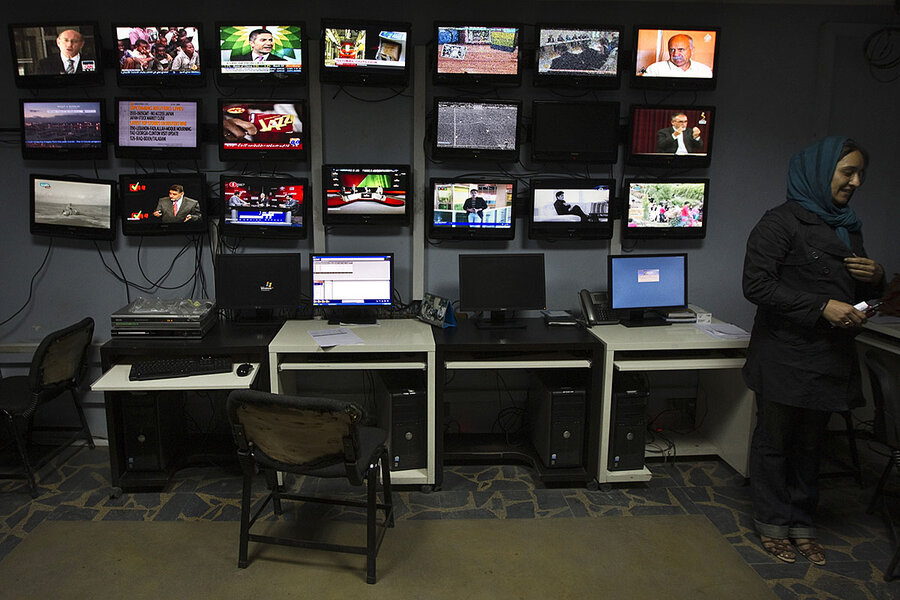
That is no surprise to Shogofa Sediqi, chief director of Zan TV (Women’s TV), who has for years received death threats for her work at a channel dedicated exclusively to women’s issues and empowerment.
Zan TV closed abruptly with the Taliban arrival. Disbanded, too, is Zan TV’s journalism academy for women, which produced 60 graduates.
“It is a challenging time for [female journalists] these days,” says Ms. Sediqi, contacted from a quarantine center in Canada after a rushed exit from Afghanistan. “All our achievements were destroyed and wasted. They are worried and have been scared. ... Nothing exists there to progress their career. ... Everything has changed.”
She says she does not believe Taliban assurances about accepting an open media.
“How is it possible to believe in a group of people who have always been against women’s rights and were killing children, and made suicide attacks among ordinary people?” says Ms. Sediqi. “If they changed their mindset, they would never put restrictions on freedom of expression, the media networks, [or] women working and the clothes they wear.”
Defending Afghan women is a job far from done for Ms. Sediqi. “Our struggle is ongoing. We didn’t accept defeat,” she says.
But the price has been high, and paid repeatedly before and after the Taliban takeover.
“Fear in our hearts”
Ms. Sediqi’s sister, Zahra, was a television presenter for Ariana News, and lost her best friend and fellow Ariana presenter Mina Khairi in a car bomb on June 3 that was claimed by the Islamic State.
That explosion made her “very discouraged for my career because I lost one of my colleagues in front of my eyes,” says Zahra Sediqi, now also in quarantine in Canada.
Fellow journalists in Kabul tell her of “vast changes” to media programs since the Taliban took over, and that their jobs are getting more difficult.
“With each passing day, the Taliban are narrowing the field of work for journalists, and leaving fear in our hearts,” says Ahmad Navid Kavosh, a reporter for Khurshid TV.
While reporting at the Kabul airport on Aug. 18, he was beaten by one Taliban fighter on his shoulder, back, and legs, while another pointed his Kalashnikov assault rifle at him and said, “Go, or we will break your camera and imprison you!”
Mr. Kavosh says he remains traumatized.
“I censored myself to survive, and this is the heartache of hundreds of Afghan journalists who are in complete despair,” he says.
“When they shut the mouth of a journalist who has always spoken freely, revealed the truth, and people expect him to [do so], it is natural that he is not alive, but among the living dead.”

Why Canadian elections aren’t following the polarized US example
Canadians have watched concernedly as political polarization has divided the United States. But centrism appears to be winning the day in Canada’s national elections.
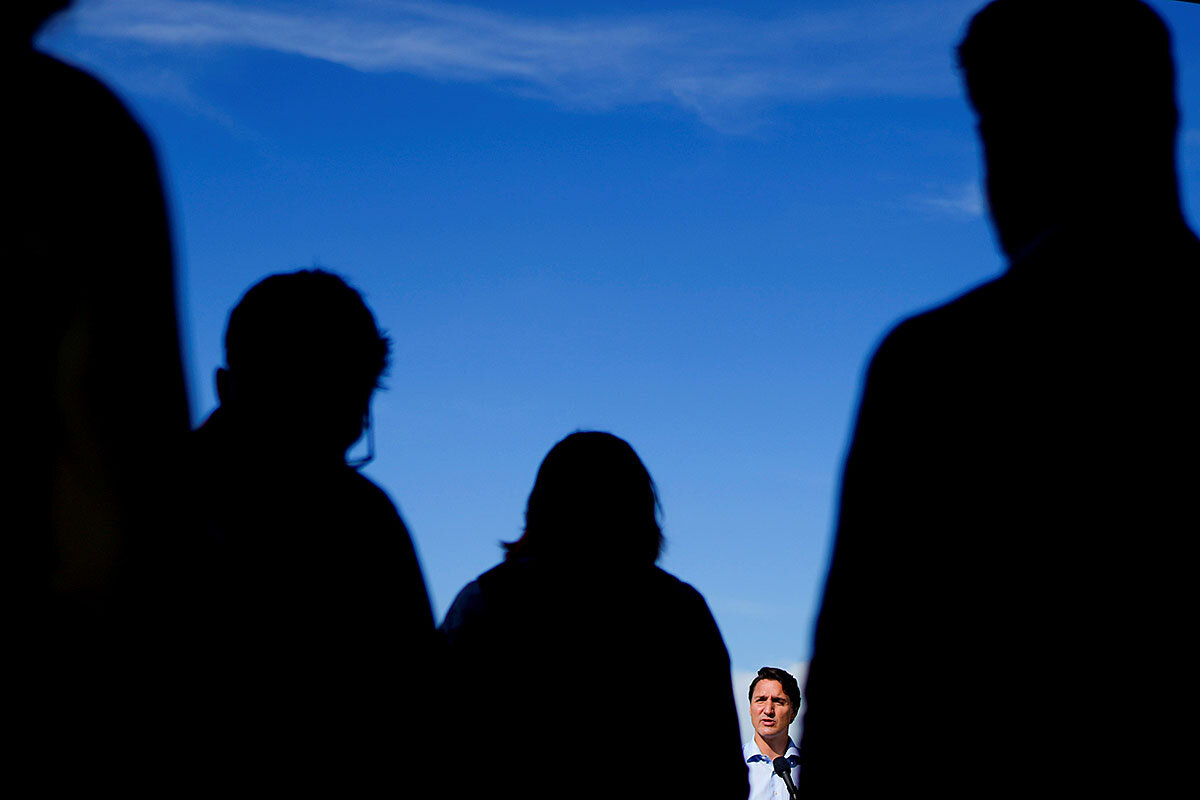
- Quick Read
- Deep Read ( 4 Min. )
For many Canadians, the campaign ahead of the snap elections on Sept. 20 has been full of partisan spite, perhaps never more clearly than when a member of the right-wing People’s Party of Canada threw gravel at Prime Minister Justin Trudeau on the campaign trail earlier this month.
But political analysts say that’s not the full picture.
They say this race has been one of least contentious in recent history. As conservatives in the United States and several European countries have moved further right to capture votes, in Canada the Conservatives have tracked to the center. And the mainstream parties have remained united in the country’s biggest challenge: fighting the pandemic.
“Everybody in politics right now will tell you that the tone has become nastier and coarser,” says Maxwell Cameron, a political science professor at the University of British Columbia. “I think one of the things that’s most interesting about this election is that it’s not really a particularly polarized election across a wide range of issues.”
Why Canadian elections aren’t following the polarized US example
Ever since Canadian Prime Minister Justin Trudeau called snap elections for Sept. 20, he has been dogged on the trail by enraged protesters. Most of the time, they have just hurled threats and insults at the prime minister – primarily over his vaccine mandates. But at an event in London, Ontario, one person identified as a local organizer for the People’s Party of Canada – a right-wing party that didn’t even get 2% in the last election but is now polling around 6% – hurled gravel, too.
For some Canadians, it’s a sign that American-style political polarization is creeping north of the border.
But political analysts say that perspective misses the forest for some particularly rancorous trees.
In debate and platform, they say, this race has been one of the least contentious in recent history. As conservatives in the United States and several European countries have moved further right to capture votes, over everything from immigration to pandemic response, in Canada the Conservatives have tracked to the center. And the mainstream parties have remained united in the country’s biggest challenge: getting ahead of the fourth wave of COVID-19.
“Everybody in politics right now will tell you that the tone has become nastier and coarser,” says Maxwell Cameron, a political science professor at the University of British Columbia. “I think one of the things that’s most interesting about this election is that it’s not really a particularly polarized election across a wide range of issues.”
And so this campaign has, in one way, offered a counternarrative to the idea that the hollowing out of the middle has led parties to move to the margins in order to mobilize a polarized electorate.
Most of this is explained by the political strategy of Conservative candidate Erin O’Toole. He has staked a place further center than his predecessors, former party leader Andrew Scheer and former Prime Minister Stephen Harper, whose vow in 2015 to ban the niqab headscarf worn by some Muslim women became a flashpoint of identity politics.
In the context of massive government spending to support workers during the pandemic, Mr. O’Toole appears less hawkish on debt. And on social issues he has presented his as a party of inclusion. He says he is firmly in favor of abortion rights, unlike Mr. Scheer, whom Mr. Trudeau defeated in 2019. “We’re not your dad’s Conservative Party anymore,” he said this week.

Critics worry that it’s an electoral ploy and that a Conservative government would be lax on public health measures and guns. But the strategy to capture moderates reflects the electorate, says Christopher Cochrane, associate political science professor at the University of Toronto Scarborough. “The Conservative Party had been moving to the right of the Canadian public,” he says. Mr. O’Toole today returns the party to “an older conservative tradition in Canada that I think a lot of people thought, and maybe rightly, was effectively dead.”
This move to the center could cost the race for Mr. Trudeau, who himself has become a global face of centrism at a time when far-right movements have grown around the world.
The Liberals and Conservatives are neck and neck – at 31.9% and and 30.4% respectively, according to Nanos Research’s nightly tracking data for CTV News and The Globe and Mail.
It’s a much tighter race than the Liberals foresaw when they called it in mid-August, after only two years in office, hoping to turn a minority government into a majority. The challenges of a pandemic fourth wave became clear almost immediately afterward.
Now voters like Safiya Ali, who lives in Greater Toronto, are calling out a double standard. The public was asked to miss weddings and funerals but is now being called to the polls. Ms. Ali has always voted Liberal; now she’s not sure she’ll vote. “I don’t think the election should have been called,” she says.
Canada, until now, had not been riven by the pandemic, which has also kept polarization at bay. All five leaders of the major parties recorded a message together, urging Canadians to get vaccinated, ahead of their only English-language debate.
But the race has revealed a growing risk to that unity. For starters, it has given a bounce to the People’s Party of Canada, which has turned into a vaccine-skeptic party attractive to voters like Jamie Schmelzle. She drives a streetcar in Toronto and says job creation is her No. 1 concern. She has voted Liberal her whole life, but now she is thinking about casting for the People’s Party because she is against vaccine mandates. “They believe in freedom of choice, which is what Canada’s based on,” she says.
Daniel Béland, director of the McGill Institute for the Study of Canada in Quebec, sees two risks of polarization ahead. If Mr. O’Toole loses with a moderate message, the party could lurch right again. “And as the Conservative Party is moving towards the center, there will be some people who are disenfranchised, who don’t accept this more centrist approach.” They could move to the People’s Party.
For now, the mainstream parties have condemned the protesters badgering Mr. Trudeau – as well as anti-vaccine protests that have targeted hospitals in recent days – instead of chasing their vote.
“One way in which Canada differs from other countries is that there’s still a strong centrist anchor in our political parties,” says Jaskaran Sandhu, a political strategist in Brampton, Ontario.
But he says polarized sentiment in the rise of the People’s Party needs to be confronted squarely, not brushed under the carpet in a bid to keep politics cordial. “While it may be a fringe, it’s incredibly problematic. It can’t just be dismissed or ignored, which is how Canada tends to deal with a lot of these issues. There’s a need for a deeper understanding that these sentiments exist.”

Russians vote Sunday. Why don’t dirty tricks dissuade the opposition?
Why do opposition-minded Russians vote in the elections? Because despite the state's tight controls over parties and the dirty tricks of the ruling United Russia, voting can make a difference.

- Quick Read
- Deep Read ( 7 Min. )
Russia officially declares itself to be a democracy. Russian media covers the campaigns much as the Western press covers elections. And just about everyone agrees that the elections do matter.
But while 14 parties, covering a wide spectrum from left to right, will be competing for seats in Russia’s lower house of parliament in a Sept. 19 election, opposition parties are carefully managed by the Russian state. The gamut of “loyal opposition” parties is genuine, and much of the criticism expressed by them can be as biting as in any Western democracy. But via electoral controls, individual pressure on candidates, or political “dirty tricks,” the state keeps any party or candidate who becomes a significant threat to the ruling United Russia party from success at the polls.
Still, opposition candidates believe running is worthwhile.
“Little by little, even small drops of water can wear down a stone,” says Oleg Mandrykin, a candidate for the liberal Yabloko party. “We do not need any more revolutions in this country. That leaves us only with gradual, democratic methods to bring about the changes we need. And we’ve seen some small, local victories that suggest it can happen.”
Russians vote Sunday. Why don’t dirty tricks dissuade the opposition?
Oleg Mandrykin, who is running for a seat in the State Duma, Russia’s lower house of parliament, believes that even Russia’s opaque, Kremlin-managed electoral system can be made to work in the interests of Russian voters if people get out and participate.
“Little by little, even small drops of water can wear down a stone,” says Mr. Mandrykin. “We do not need any more revolutions in this country. That leaves us only with gradual, democratic methods to bring about the changes we need. And we’ve seen some small, local victories that suggest it can happen.” That’s the optimistic side of the debate that breaks out whenever Russia holds an election, as it will be on Sept. 19 for the Duma and a multitude of regional and local legislatures.
Then he launches into the list of daunting obstacles he has faced, including official harassment because he is a candidate for the liberal opposition Yabloko party.
Russia officially declares itself to be a democracy. Russian media covers the campaigning almost like a horse race, much as the Western press covers elections. And just about everyone agrees that the elections do matter, though opinions differ over the reasons.
But while 14 parties, covering a wide spectrum from left to right, will be competing for seats in the Duma, opposition parties are carefully watched and managed by the Russian state. The gamut of “loyal opposition” parties is genuine, and much of the criticism expressed by them can be as biting as the differences between candidates in any Western democracy. But via electoral controls, individual pressure on candidates, or simple political “dirty tricks,” the state keeps any party or candidate who becomes a significant threat to the ruling United Russia party from success at the polls.

This year, United Russia seems to be in particular trouble at the polls, which experts say could reflect badly on President Vladimir Putin, whom the party lines up behind. And they warn that could mean the opposition parties will be victim to even more electoral trickery this election.
“There are signs that the Kremlin is very nervous about the outcome of these elections,” says Masha Lipman, editor of Point & Counterpoint, a journal of Russian affairs published by George Washington University. “The so-called menu of manipulations is much broader than in the past. Even though Putin’s rating remains high, perhaps because he is seen as the guarantor of stability, United Russia is no longer regarded as a force for good.”
A controlled election
There are 450 Duma seats at stake in Sunday’s elections, half of which will be allotted by party line voting, the other half by 225 constituency races such as the one Mr. Mandrykin, a popular local environmental activist, is contesting in the Arctic region of Arkhangelsk. Six of the 14 parties competing – including the Communists, the nationalist Liberal Democratic Party of Russia, and the social democratic Fair Russia party – got more than 5% of the vote in the polls five years ago, earning them seats in the Duma, so they expect at least to repeat their performance.
Proponents of the system say that it fulfills Russia’s need. “I think the existing electoral system reflects adequately the voter’s will,” says Viktor Kuznetsov, United Russia candidate in the central Russian region of Samara. The 14 parties running “actually represent the full spectrum of political forces in our society.”
Ms. Lipman says the Kremlin wants to be assured of a parliamentary majority for United Russia, to quell any disquiet among Russia’s notoriously fractious elites about Mr. Putin’s grip on the country. Some opinion polls suggest that United Russia’s current support could be as low as 27%, far down from the 54% it won in 2016.
“In Russia, an election campaign is a referendum on the president,” says Dmitry Oreshkin, an independent political observer. “If the voters’ support is strong, it means they trust a strong Putin. If not, it means Putin looks weak.”
In a show of just how important Russian elections can be, the Kremlin’s harshest critic, jailed anti-corruption activist Alexei Navalny, has urged his followers to go to the polls. But he has called upon them to practice “smart voting”: concentrating votes behind any candidate from the approved “systemic opposition” who seems likely to defeat the official United Russia entry. His supporters have compiled a list of over 1,000 such candidates to back. Ironically, the majority of those are from the largest official opposition party, the Communists, who stand to benefit most from the backing of Mr. Navalny’s youthful and liberal followers.
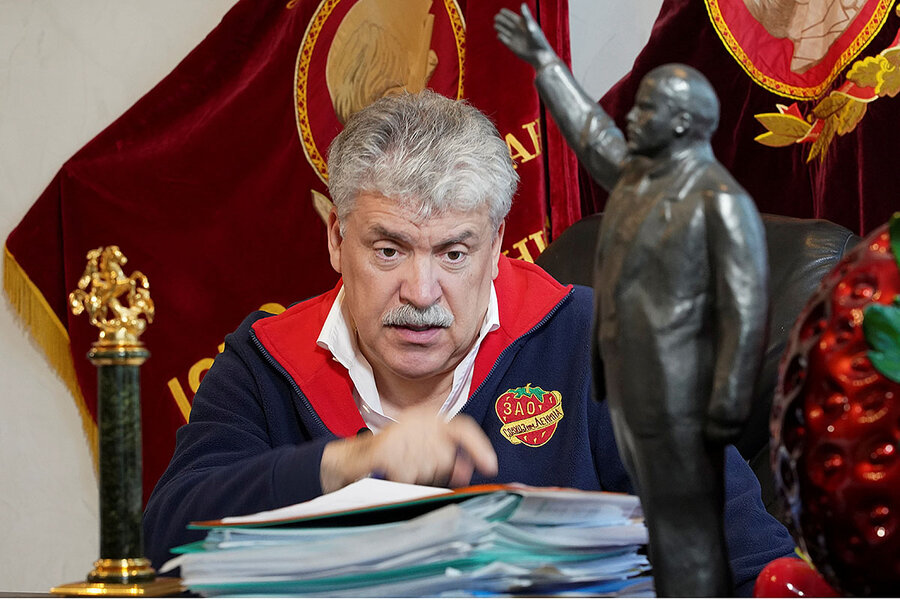
That’s where the limitations on Russian democracy begin to become clear. The main reason Mr. Navalny must resort to throwing his weight behind candidates who are, basically, differing shades of pro-Kremlin, is that he and his millions of followers have been labeled “extremists” by the Russian government. They have been forced to disband their organizations and are banned from running in elections. Several other groups, mainly pro-Western liberals but also right-wing nationalists, have been similarly clipped from the permitted political spectrum.
“For those Russians who care about liberal ideas, democracy, and civil liberties, there are no candidates among the permitted parties running to represent them,” says Ms. Lipman. “The cutoff point for the Kremlin seems to be that nobody representing liberalism or Westernizing, modernizing ideas should be represented in the Duma.”
Barred candidates and dirty tricks
In addition to landscaping the political garden to weed out ideological threats, the Central Election Commission also employs a range of tools to bar individual candidates who are deemed insufficiently loyal or too popular. In the current election cycle, even the powerful Communist Party was compelled to drop Pavel Grudinin, one of its most appealing candidates and head of a prosperous collective farm near Moscow, after murky allegations were made about financial improprieties by his former wife.
Another sign of the Kremlin’s nervousness is the efforts by the state media watchdog, Roskomnadzor, to block Russian search engine Yandex from providing access to Mr. Navalny’s “smart voting” list of candidates.
Most experts say that actual vote-counting and polling station procedures on election day have been greatly cleaned up since obvious official voter fraud in the 2011 Duma elections triggered mass protests. But campaigning has been marked by dirty tricks, which critics insist are instigated by United Russia. They say the party uses its vast resources to manipulate the ballot, often employing smaller parties as its agents to make things difficult for strong Communist or Yabloko candidates. A pandemic-era ban on public meetings has made most open campaigning, formerly permitted, almost impossible for candidates from smaller parties.
A good example of dirty tricks is “doubling,” or getting a small party to run someone with the same name as a popular challenger. In St. Petersburg, two “Boris Vishnevsky” ballot entries, the result of two recent name changes accepted by the electoral authorities, suddenly appeared to run against the veteran Yabloko candidate Boris Vishnevsky.
“I don’t remember this kind of tactic being used before,” says Mr. Vishnevsky. “I was expecting more traditional methods to be used against me, like criminal charges or house arrest. Instead, these two guys, whose names were Shmelyov and Bykov until recently, are put on the ballot to confuse voters and take votes away from the dangerous candidate. It just means we have to try harder.”
Mr. Mandrykin, who was interviewed by the Monitor in late August, got a taste of poisoned media coverage when a local news agency, Ekho Severa, published what appear to be surveillance photos of the meeting, under the headline “Mandrykin, Who Do You Serve?” along with the suggestion – obvious but not explicit – that he discussed funding with a “foreign emissary.”
Reached for commentary, Ekho Severa Editor Ilya Azovskiy insists, “The word ‘emissary’ doesn’t have any negative meaning. Fred Weir, as a foreign journalist, is an emissary of a foreign state. We didn’t write directly that he financed Oleg Mandrykin’s campaign. ... I am sure that if I called up The Christian Science Monitor, they wouldn’t explain their editorial policy. So why should I?” (Editor’s note: Mark Sappenfield, the editor of The Christian Science Monitor, says, “The Monitor’s editorial policy is a matter of public record and a point of pride. We are eager to discuss it with anyone who has a genuine interest.”)
Given all that he’s had to go through, it might be hard to explain why Mr. Mandrykin even wants to run for the Duma.
“An elected deputy has the right to take the podium and to say what he thinks needs to be put on the record,” he says. “He or she has the right to meet with officials, ask questions, have input into the budget. Also the right to have 40 assistants, with a local office, and the right to meet with constituents, gather information, and respond to demands. If I get the chance, I will use these rights and make it matter.”

Graphic
Pandemic took bite out of US economy. Yet millions escaped poverty.
During economic hard times, one role that government can play is shock absorber. New Census Bureau data show the difference that Congress’ quick assistance for millions of Americans made in 2020.
When the coronavirus pandemic shuttered much of the economy in the spring of 2020, about 1 in 7 U.S. workers abruptly lost their jobs. That’s more than twice the scale of job losses seen during the Great Recession of 2007 to 2009. Help was needed, and fast.
As Congress was moving to pass relief legislation, Melissa Kearney and Luke Pardue, University of Maryland economists, researched the difference that cash payments could make for affected households. They found that average workers in the hard-hit leisure and hospitality sector, for instance, were earning just $20,000 a year, owed about $1,000 in monthly rent, and often had children to support.
Federal actions at the time included stimulus checks and expanded unemployment insurance – and this week the U.S. Census Bureau released data on the resulting boost. There was still hardship, as the aid didn’t always get quickly to those who needed it most. But in all, more than 17 million Americans avoided poverty thanks to pandemic relief programs – in addition to more than 30 million who were already lifted above the poverty line by existing federal programs like Social Security.
The federal aid came at a cost – adding to national debt. But conservative economic analyst Scott Winship summed up the outcome this way in a tweet this week: The “CARES Act and other extraordinary policy measures from last spring worked.” – Mark Trumbull / Staff writer
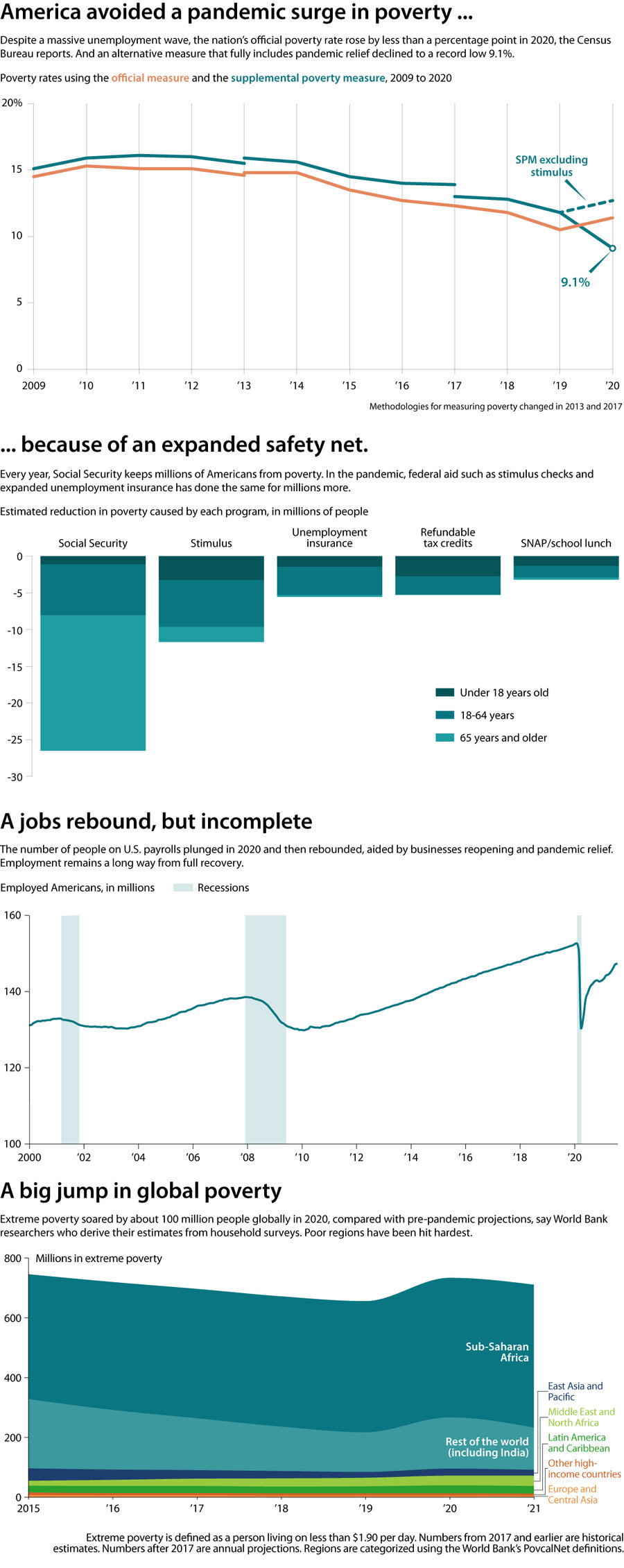
U.S. Census Bureau, U.S. Bureau of Labor Statistics, World Bank

Essay
Is ‘Persuasion’ the Jane Austen story we all need right now?
How relevant is the work of Jane Austen to a society making its way through a pandemic – and a racial reckoning? With more stage and screen versions of “Persuasion” emerging, an essayist considers the intersection of Regency times and ours.
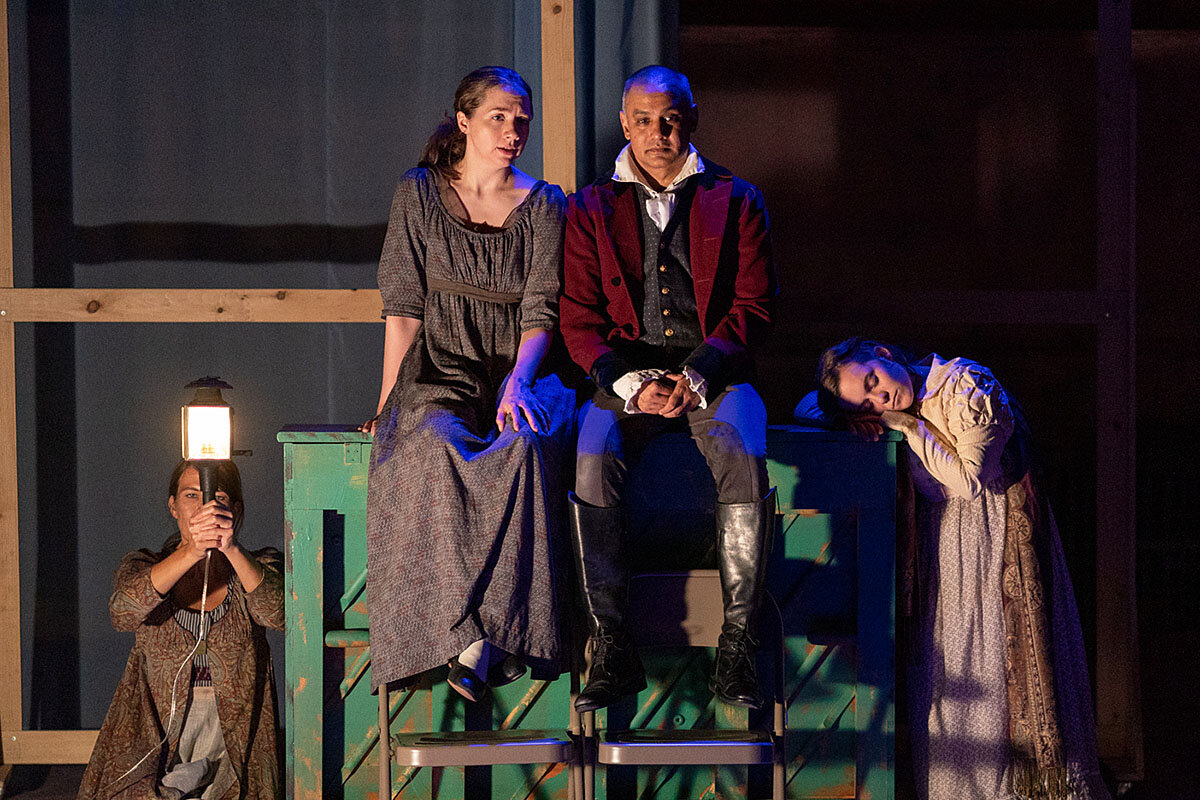
- Quick Read
- Deep Read ( 6 Min. )
-
By Janet Saidi Correspondent
Jane Austen’s Regency world is not a bad place to escape to in a time of crisis, as I learned last year. Because under all the romance and bucolic country walks, characters are bearing up after insults and injury brought on by class, gender, displacement, and loss.
No Austen hero exemplifies this quiet endurance more than the persevering Anne Elliot from “Persuasion.” This most soulful of Austen’s stories is reigniting, with two film adaptations due next year and an off-Broadway adaptation from Bedlam theater company, currently in previews, scheduled to run through the end of October.
My literary journey led not only to conversations about Austen’s six iconic novels but also to an entire network of readers and thinkers, including those reflecting on the racial reckoning sparked by the murder of George Floyd. What becomes clear is that Austen is for everyone, and can help us through the times we’re in.
“Even if ... I’m reading it in 2021, these are my people,” says Damianne Scott, an adjunct English instructor who is writing a “Persuasion” adaptation set in a modern Black megachurch. “This is what’s going on in my life in my world, too. And she’s speaking to me.”
Is ‘Persuasion’ the Jane Austen story we all need right now?
Last February, during the long winter of the pandemic and almost a year into lockdown, struggling through endlessly quiet hours and freezing temperatures, I turned to Jane Austen. The plan was simply to reread her six major novels. But that simple plan unlocked for me not only new conversations about these iconic novels but also an entire network of readers and thinkers.
As it turns out, Austen’s Regency world is not a bad place to escape to in a time of crisis. Because under all the romance plots and bucolic country walks, characters like Elizabeth Bennet in “Pride and Prejudice” are not only dancing in halls and drinking tea; they’re also bearing up after insults and injury brought on by class, gender, displacement, and loss.
No Austen hero exemplifies this quiet endurance more than the pining and persevering Anne Elliot from “Persuasion.”
This most soulful of Austen’s stories is reigniting. Two film adaptations are due next year – one from Netflix and MRC Film starring Dakota Johnson and another from Searchlight Pictures starring Sarah Snook. And an off-Broadway adaptation from Bedlam theater company, currently in previews, is scheduled to run through the end of October.
Austen’s last full novel, “Persuasion,” published months after her death, is steeped in longing (or pining, as romance aficionados call it), as the two protagonists – Anne and Capt. Frederick Wentworth – have been driven apart but still inhabit each other’s dreams. Because of the radical interiority of Austen’s writing, known to critics as her method of “free indirect discourse,” readers intimately live and breathe and pine – and ultimately survive – alongside Anne.
“Anne has been my imaginary friend for more than half my life,” says Sarah Rose Kearns, the playwright behind the Bedlam production, who first read the novel as a middle schooler and has communed with Anne ever since. Ms. Kearns says Anne handles her anxiety and depression gracefully, but Austen’s literary technique lends emotional depth.
Compared with “Pride and Prejudice,” “Persuasion” is “so much less suspicious of emotion. ... But this one is certainly a celebration of romantic love in the end, right?” says Ms. Kearns.
Indeed. “I call it an adult fairy tale,” says Damianne Scott, an adjunct English instructor at the University of Cincinnati’s Blue Ash College who lectures on Austen in the classroom and in the Austen community. She says “Persuasion” is her favorite because the story is about a young woman taking on family responsibility, which she can relate to. And it’s also about second chances, which we all can relate to.

As the organizer of the Facebook page Black Girl Loves Jane, Ms. Scott says since encountering the novel in high school, she has strongly related to Anne’s graceful navigation of financial and familial quagmires.
Ms. Scott says she also appreciates contemporary adaptations and retellings of other Austen novels like Ibi Zoboi’s “Pride,” which sets “Pride and Prejudice“ within a Brooklyn multiracial family, and “Unmarriageable,” by Soniah Kamal, which puts the story in Pakistan. These retellings reinforce for her that Austen’s world is her world, she says, even if people who look like her aren’t always well represented in Austen discussions or in film adaptations.
“These are my people,” she says. “Even if ... I’m reading it in 2021, these are my people. This is what’s going on in my life in my world, too. And she’s speaking to me.”
Stories for the times we’re in
Back in those long winter nights after a year of lockdown, the pandemic wasn’t the only significant thing going on. The murder of George Floyd and the racial uprisings that followed inspired a reckoning about white supremacy and racial inequities at every level of society, and this reflection was also taking place in the conversations I was finding about Austen.

Ms. Scott and scholars like historian Gretchen Gerzina and University of North Carolina-Chapel Hill professor Danielle Christmas, who co-hosted the Jane Austen & Co. series “Race and the Regency,” spoke to pandemic-era Zoom rooms attended by hundreds of Austen readers gathered across cultures and continents. Working from home with a makeshift audio production studio at hand, I soon found myself launching a podcast and exploring, with some of the scholars and fans I’ve included here, questions about what Austen’s stories offer for the times we’re in.
One subject we often came back to: “Bridgerton.” When the show debuted on Netflix at the end of 2020, it changed everything we thought we appreciated about Regency stories. The racy series brought the gift of escapism, and with its color-conscious casting (a departure from the books on which it is based), it challenged and boldly revisioned that Regency world, putting Black citizens within and at the top of the aristocracy.
“I actually think it does really important work,” Dr. Christmas told me during our podcast taping about bingeing “Bridgerton.” “There are dozens of future Jane Austen adaptations to come, because we love them, right? ... And I actually think that ‘Bridgerton’ is insisting that the next time there’s a production, if they decide to insist on a certain kind of casting, they’re being deliberate and intentional about that.”
It’s a view shared by an increasing number of Austen scholars and fans, including those writing adaptations themselves like Ms. Kearns and Ms. Scott. The Bedlam production includes a diverse cast, and Ms. Kearns, who serves on the Equity, Diversity, and Inclusion Committee for the Jane Austen Society of North America (JASNA), says this is right on many levels.

“One thing that I am mindful of when I think about casting and British period pieces,” she says, “is that Britain in Jane Austen’s lifetime was a lot more diverse than it appears to be in many of the film versions.”
Scholars like Dr. Gerzina and David Olusoga in the United Kingdom are unearthing the stories of Black British lives in the 18th and 19th centuries, providing fans of “Bridgerton” and Austen a place to go for historical context.
Ms. Scott says she’s excited about the Netflix “Persuasion” production deploying what she calls “nontraditional casting,” including “Crazy Rich Asians” heartthrob Henry Golding as Anne’s cousin, William Elliot. However, she says she’s encountered resistance to a piece she wrote for JASNA on the “pineapple emoji craze” and the PBS series “Sanditon.” When Black viewers called for “Sanditon” fans to stop using a pineapple emoji to symbolize the fandom – explaining that it unhelpfully symbolizes both reverence toward and trivialization of colonialism and the slave trade – a debate broke out, and Ms. Scott weighed in.
Now, Ms. Scott is writing her own “Persuasion” retelling: Her novel “Persuaded,” due from Meryton Press next year, sets the story of Anne Elliot in a contemporary Black megachurch. Like Austen’s Sir Walter, Anne’s father, Ms. Scott’s megachurch pastor is weak on financial planning and strong on superficial appearances.
“Among the people”
Meanwhile, Ms. Scott says she supports the Austen fandom celebrating films, romance, and Regency dresses. “I’m all for you learning how to make a bonnet. I want to make a bonnet, too,” she says. But the problem comes when we make Austen transcendent, placing her outside the world she herself lived in.
“We make her so unreachable,” she says. “The one thing about my generation – Generation X, Y, even millennials – is we’re not looking for people to put on pedestals. We want people to be among the people. And Austen is among the people, if you let her be.”
Janet Saidi is a journalist who’s assigned herself the Jane Austen beat. When not working on her podcast and newsletter, The Austen Connection, she is producing at NPR-affiliate KBIA radio and lecturing at the Missouri School of Journalism.
Other headline stories we’re watching
(Get live updates throughout the day.)The Monitor's View
New ways to curb climate migration
- Quick Read
- Deep Read ( 2 Min. )
-
By the Monitor's Editorial Board
Extreme weather events, many of which are rooted in climate change, could displace some 216 million people within their own countries by 2050, finds a new study from the World Bank. And that is only in poorer countries. Added to the tens of millions of people who have fled war or political strife – as witnessed in Afghanistan – solutions to forced migration are more urgent than ever.
The report notes that planners could identify places most likely to be hit hardest by climate change and help the more climate-resilient areas nearby prepare to take in migrants. Many other ways to help ease climate migration are available. More drought-resistant crops, for example, are being developed that could help keep farmers home. Rooftop water harvesting can be used to irrigate fields. In some villages in India where water harvesting and other water conservation methods are being undertaken, climate migration has been reversed and migrants are returning to their homes.
Ways to mitigate climate migration are becoming well known. Even as nations try to curb carbon emissions, they can also put measures in place to solve the rising displacement of people by weather disasters.
New ways to curb climate migration

Extreme weather events, many of which are rooted in climate change, could displace some 216 million people within their own countries by 2050, finds a new study from the World Bank. And that is only in poorer countries. Another study estimates that every additional day each year with an average temperature of about 90 degrees Fahrenheit adds nearly 1% to the number of climate migrants. Added to the tens of millions of people who have fled war or political strife – as witnessed in Afghanistan – solutions to forced migration are more urgent than ever.
The World Bank’s new research, titled Groundswell 2.0, offers this suggestion: If governments take quick remedial action they could cut internal migration, and the hardships it brings, by as much as 60% to 80%. The action most needed would be to reduce worldwide emissions of greenhouse gases. A United Nations Climate Change Conference of the Parties (COP26) is scheduled to be held in early November in Glasgow, Scotland, a follow-up to the Paris climate accords of 2015.
As governments struggle to pledge and keep promises to reduce emissions, the World Bank says concurrent steps can be taken to build resiliency and fend off the worst effects of climate migration. These include ways to help people stay in their homes, as well as to help in their movement to and resettlement in new locations.
In Egypt, for example, parts of the Nile delta are projected to be places of out-migration. Several cities, including Cairo, should expect to receive these refugees. The report notes that planners could identify places most likely to be hit hardest by climate change and help more climate-resilient areas prepare to take in migrants.
Many other ways to help ease climate migration are available. More drought-resistant crops, for example, are being developed that could help keep farmers home. Rooftop water harvesting can be used to irrigate fields.
In some villages in India where water harvesting and other water conservation methods are being undertaken, climate migration has been reversed and migrants are returning to their homes, says Sunita Narain, director general of the Center for Science and Environment in New Delhi, in a recent interview with The Times of India. “It is essential to invest in building local climate resilience and protecting community economies,” she added.
Ways to mitigate climate migration are becoming well known. Even as nations try to curb carbon emissions, they can also put measures in place to solve the rising displacement of people by weather disasters.

A Christian Science Perspective
Each weekday, the Monitor includes one clearly labeled religious article offering spiritual insight on contemporary issues, including the news. The publication – in its various forms – is produced for anyone who cares about the progress of the human endeavor around the world and seeks news reported with compassion, intelligence, and an essentially constructive lens. For many, that caring has religious roots. For many, it does not. The Monitor has always embraced both audiences. The Monitor is owned by a church – The First Church of Christ, Scientist, in Boston – whose founder was concerned with both the state of the world and the quality of available news.
What’s more powerful than fire?
- Quick Read
- Read or Listen ( 3 Min. )
-
By Laurie Toupin
Whether the “fires” we’re faced with are literal or figurative, we can turn to God for inspiration that guides us safely through – no matter our age or location.
What’s more powerful than fire?
One day when I was around 10 years old, my best friend and I were briefly home alone while my parents were at work. (This was not uncommon in those days.) My parents had always told me not to play with fire, but I decided to start a fire in the fireplace in the basement.
Unfortunately, I neglected to open the chimney flue. When my friend and I opened the door to go back downstairs after making a snack to enjoy in front of the fireplace, gray smoke billowed out of the basement into the kitchen.
I was terrified. I knew that starting a fire without my parents was wrong, and I didn’t know how to correct the situation I’d caused.
Then I thought of something from the Christian Science Sunday School I attended. My teacher always reminded the class that we could turn to God no matter what the circumstance and that we could expect results. So that’s what I did. I prayed a prayer I said each night before bed, written for little children by the discoverer of Christian Science, Mary Baker Eddy:
Father-Mother God,
Loving me, –
Guard me when I sleep;
Guide my little feet
Up to Thee.
(“Poems,” p. 69)
This brought the comforting assurance that God was right there with my friend and me, protecting, guarding, and guiding us.
There’s a story in the Bible of three men who were thrown into a fiery furnace as punishment because they worshiped God instead of the golden statue the king had set up. But God protected them. The New King James Version says that “the fire had no power” on their bodies; “the hair of their head was not singed nor were their garments affected, and the smell of fire was not on them” (Daniel 3:27). They had been protected in this terrifying situation.
I reasoned that if those men could walk through and out of a furnace unscathed, then God could certainly protect my friend and me in this situation. I mentally thanked God for loving and watching over us and the rest of my family as well.
As I did this, I felt enveloped in love. I understood somehow that all would be well. God, divine Love, created us as His completely safe, loved, spiritual sons and daughters. No matter the human circumstances, we can lean on this spiritual fact and be receptive to the healing inspiration God sends to everyone.
That’s what happened to me that day. As I prayed, the terror left, and the steps we should take came to me as clearly as if someone were speaking directly to me. My friend also remained calm, and together we were able to take the necessary steps to protect ourselves and my home. Nothing was lost. (Although I did, quite rightfully, get into trouble when my parents got home!)
Whether the “fires” we face are literal or figurative, divine protection and guidance are not exclusive to certain people or times. They are here with us all, constantly. Divine goodness, beauty, Life, and Love are forever intact, for they are spiritual and cannot be destroyed.
Mrs. Eddy’s book “Science and Health with Key to the Scriptures” includes a glossary of metaphysical definitions of biblical terms. It defines “fire” as “fear; remorse; lust; hatred; destruction; affliction purifying and elevating man” (p. 586). It translates the physical concept of fire into corresponding qualities – which have no power to harm God’s creation. In fact, as we glimpse this spiritual reality that we are God’s creation, unhelpful mortal traits are destroyed.
For instance, in the case of those men in the Bible, their “fire experience” illustrated that characteristics such as deviousness, pride, and anger were not more powerful than God, good. In my case, my disobedient leanings were enduringly replaced with a humbler and more repentant attitude.
Such is the power of divine Love.
These ideas give me strength and courage to continue praying for guidance and healing for myself and others, no matter how harsh the material picture. Divine Love is the only legitimate power and not only protects and directs, but also renews, purifies, and cleanses, blessing all with its healing coolness and balm.

A message of love
Ready, set, plow
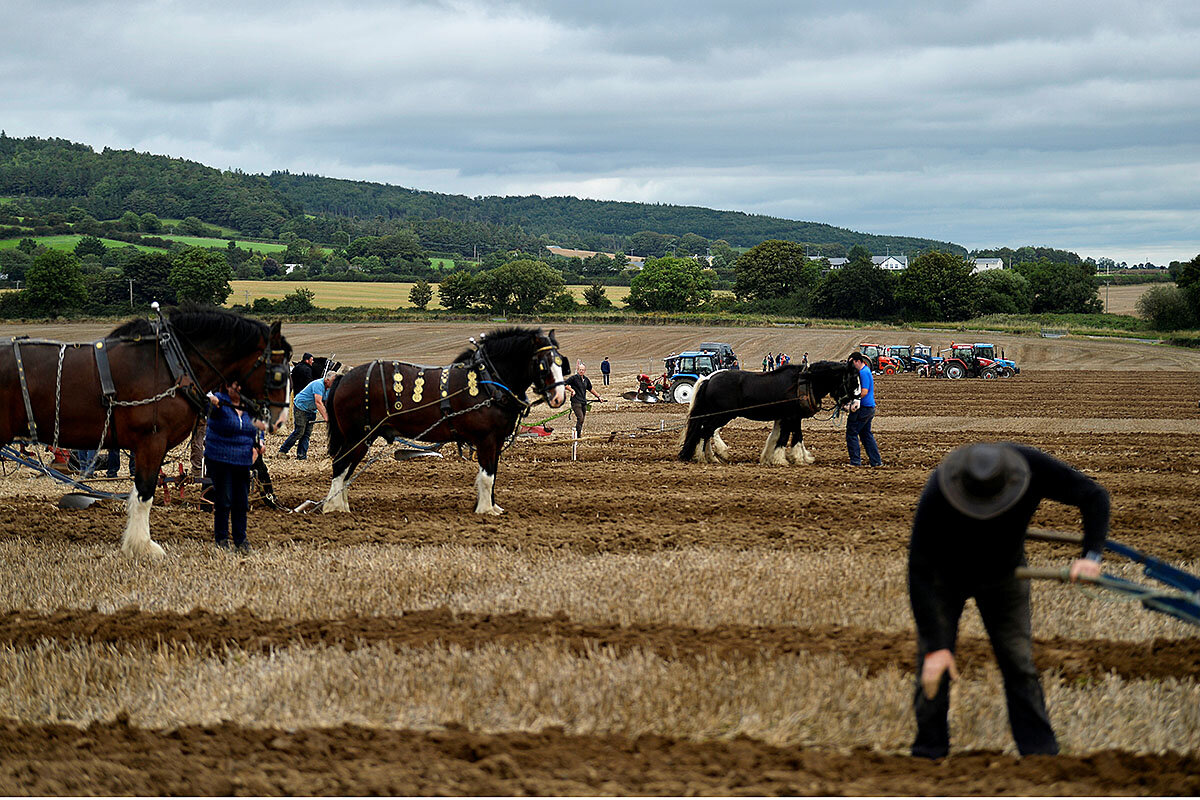
A look ahead
Thank you for joining us. Please come again Monday, when the Monitor’s Lenora Chu explores how Chancellor Angela Merkel changed Germany – and the world – after 16 years in office.




